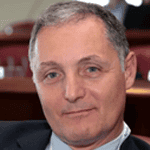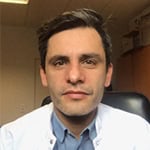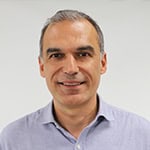Gold programme of the conference
An approach to hemodynamic management
April 3, 2025
11:00 h – 12:00 h – CEST
Accreditation reception and welcome
12:00 h – 12:15 h – CEST
Presentation of the conference
12:15 h – 12:30 h – CEST
Objectives of the conference
The scientific committee will welcome the participants and present the objectives of the conference.
12:30 h – 13:15 h – CEST
Keynote speech – Hemodynamic Monitoring: Sustainability and Accessibility
This lecture aims to address the latest developments in cardiovascular monitoring and their environmental impact. Key aspects of how to make medical equipment more sustainable and how to improve accessibility to these methods in diverse clinical settings, including those with limited resources, will be explored. During the lecture, experiences and innovative approaches to achieve more equitable and efficient care, with direct impact on patient diagnosis and treatment, will be shared.

Frederic Michard
Doctor of Medicine, specialising in Critical Care, and is one of the top 1% of the world’s most cited scientists. Pioneer in the development of graphical user interfaces for hemodynamic monitoring.
13:15h – 14:00h – CEST
Arterial pressure waveform – Morphology and artefacts
This presentation will interpret the morphology of the arterial pressure waveform and its importance and influence on hemodynamic management. In addition, the most common artefacts, their causes and the impact they can have on data accuracy will also be discussed. During the presentation, practical tools will be shared to improve interpretation and recognise error patterns, promoting optimisation in clinical practice.

Stefano Romagnoli
Full Professor of Anesthesia and Critical Care, University of Florence; Head of the department of Anesthesia and Critical Care at Careggi University Hospital, Florence, Italy. Expert in hemodynamic and brain monitoring.
14:00h – 14:30 h – CEST
Discussion – Question and Answer Session
The speakers will answer questions from the audience.
14:30 h – 15:30 h – CEST
Lunch – Break
15:30h – 16:15 h – CEST
Clinical Management of Oxygen Delivery (DO2)
This lecture will focus on the importance of oxygen transport in the clinical management of critically ill patients. The mechanisms that regulate oxygen consumption and distribution will be discussed, as well as strategies to optimise DO2 in shock, respiratory failure and other critical conditions. The speaker will also discuss tools and methods to assess oxygen transport efficiency in real time, providing crucial information to improve clinical management and decision making in the hospital setting.

Francisco Escribá
Anaesthesiology specialist at the Hospital Universitario y Politécnico de la Fe (Valencia), member of the paediatric section of SEDAR, European EAMS accredited instructor and member of the Hospital la Fe CVAD COMMITTEE.
16:15 h – 17:00 h – CEST
When anticipating arterial hypotension, and when vasopressor treatments fail to improve outcomes, questions arise about the balance between blood flow and pressure. Can an optimal equilibrium be achieved in operating theatre?

Pierre Gregoire Guinot
Professor of Anesthesia and Intensive Care at the University Hospital of Dijon, France. His research focuses on cardiovascular hemodynamics, vasoplegia, ECMO, inflammation, and bacterial translocation.
17:00 h – 17:30 h – CEST
Monitoring Cardiovascular Efficiency
This talk will discuss advanced methods to assess the efficiency of the cardiovascular system in real time. During the presentation, the key parameters for optimising cardiac performance and their impact on hemodynamic diagnosis and management will be discussed. In addition, the speaker will present innovative techniques and technologies to improve the accuracy of these measurements, as well as strategies for applying these data in the clinical setting. This session will provide practical and up-to-date tools to improve the quality of cardiovascular monitoring and treatment.

José Miguel Alonso
Specialist in anaesthesiology, resuscitation and pain management at the Hospital Universitario y Politécnico de la Fe (Valencia), with national and international experience. Passionate about hemodynamic monitoring and NIV.
17:30 h – 18:15 h – CEST
Coffee break – Break
18:15h – 18:45h – CEST
Patients on mechanical ventilation and in sinus rhythm
This talk will deal with this typology of patients.

Luis Gajate Martín.
Anaesthesiologist at the Hospital Universitario Ramón y Cajal (Madrid).
18:45 h – 19:30 h – CEST
Surprise lecture
Surprise talk with an unknown guest.

Surprise guest
A step further in hemodynamic management
4 April, 2025
09:00 h – 09:45h – CEST
Utility of PCM in ventricular assists
What is the utility of using pulse contouring methods in monitoring ventricular assistances? This paper seeks to answer this and other questions by analysing the importance of this method in dynamically assessing hemodynamic changes and adjusting treatment to the patient’s needs. The paper will explore the application of the Pulse Contour Method (PCM) in the monitoring and adjustment of ventricular assists. It will discuss how this method allows to dynamically assess hemodynamic changes and adjust ventricular assist more precisely to the patient’s needs.

Francisco Cota
Intensive Care Physician at the Hospital de la Línea de la Concepción (Cádiz). Coordinator of the Hemodynamics WG of SAMIUC. Expert in blood purification and hemodynamics.
09:45 h – 10:30 h – CEST
Preload and afterload parameters
Knowing how to interpret the parameters of preload and afterload are two essential factors for good hemodynamic management. This lecture will cover both parameters in depth, analysing both the different elements that compose them and their relevance in diagnosis and medical treatment. Factors that may influence the accuracy of the measurements will also be discussed and strategies to optimise their interpretation will be shared.

Germán Gómez
Assistant doctor of anaesthesiology and resuscitation at Son Espases Hospital (Mallorca).
10:30 h – 11:15 h – CEST
Five limits of the macrocirculation
This lecture addresses the key factors that determine the functional limits of the macrocirculation in the human body. It will discuss the five main limits that affect the large-scale circulation, including blood pressure, cardiac output, vascular resistance, vessel distensibility and vital organ perfusion. The speaker will explain how these limits interact and affect hemodynamic stability, providing strategies for the monitoring and clinical management of these parameters in critically ill patients.

Adrian Wong
MD, specialising in Critical Care, he is a consultant and clinical lead at King’s College Hospital (London). Passionate about ultrasound to guide fluid therapy, focusing on venous congestion and organ perfusion.
11:30 h – 12:00 h – CEST
Coffee break – Break
12:00 h – 12:45h – CEST
Septic Patient Management with a PCM (Pulse Contour Method)
This paper explores the application of the Pulse Contour Method (PCM) in the monitoring and management of septic patients. It will discuss how the PCM allows dynamic assessment of real-time hemodynamic response, helping to optimize perfusion and circulatory balance in patients with sepsis. It will highlight how this tool improves accuracy in decision-making and adjusts treatment according to the hemodynamic needs of the septic patient.

José Miguel Alonso
Specialist in anaesthesiology, resuscitation and pain management at the Hospital Universitario y Politécnico de la Fe (Valencia), with national and international experience. Passionate about hemodynamic monitoring and NIV.
12:45 h – 13:30 h – CEST
Closing Conference – Ztot
This presentation will develop the concept and application of total cardiovascular impedance (Ztot) in the assessment of a patient’s hemodynamic status. Dr. Romano will explain the origin of the PRAM (Pressure Recording Analytic Method), and how the ability to estimate beat-to-beat in real time in that patient cardiovascular impedance completely changed the approach to personalised hemodynamic monitoring and decision making, even in very complex and particular conditions such as IABP (intra-aortic balloon counterpulsation), ECMO, paediatric or septic patients.

Mario Salvatore Romano
PhD in Applied Pathophysiology and inventor of the PRAM method.
